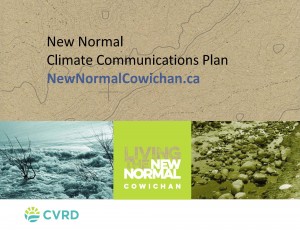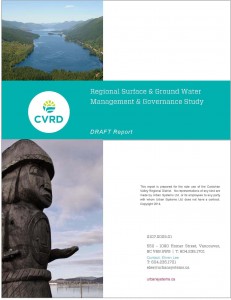Moving Towards a Water Balance Culture in the Cowichan Region

SKUTZ FALLS ON THE COWICHAN RIVER: What the Water Balance problem in the Cowichan looks like……Fall 2006 – too much water!…Summer 2006 – too little water!
The Climate in BC is Changing
The summer dry season has extended on both ends and BC communities can no longer count on a predictable snowpack and reliable rain to maintain a healthy water balance in their watersheds. Annual volumes of water entering and exiting regions are not necessarily changing; instead, what is changing is how and when water arrives – it is feast AND famine!
The Cowichan Region is a provincial leader in demonstrating how local government action can influence Water Balance outcomes.
Communicating the ‘New Normal’
“ Summer drought and winter flooding are the ‘new normal’ in the Cowichan region, and are putting water supply and the regional ecosystem under extreme stress. To foster long-term, strategic water preparedness the CVRD has launched a website that is intended to provide the community with easy, clear information and tools that make adapting to the ‘new normal’ easier,” explains Kate Miller, Manager of Environmental Services, CVRD Engineering & Environmental Services Department.
Summer drought and winter flooding are the ‘new normal’ in the Cowichan region, and are putting water supply and the regional ecosystem under extreme stress. To foster long-term, strategic water preparedness the CVRD has launched a website that is intended to provide the community with easy, clear information and tools that make adapting to the ‘new normal’ easier,” explains Kate Miller, Manager of Environmental Services, CVRD Engineering & Environmental Services Department.
 “The New Normal Cowichan initiative illustrates what putting ‘water balance thinking’ into action looks like from a communications perspective. The branding for the New Normal uses images and words that inform and educate, with a focus on practical actions that emphasize what is possible: Drought Smart, Flood Smart and Smart Tools.”
“The New Normal Cowichan initiative illustrates what putting ‘water balance thinking’ into action looks like from a communications perspective. The branding for the New Normal uses images and words that inform and educate, with a focus on practical actions that emphasize what is possible: Drought Smart, Flood Smart and Smart Tools.”
Changing How Decisions are Made
 “Recurring region-wide consequences of water-related challenges have also prompted regional action to develop governance structures and processes to make the connections between high-level decision making and actions on the ground. The Regional Surface and Ground Water Management and Governance Study identified co-governance with First Nations as a primary condition for success in managing regional water resources,” continues Keith Lawrence, Senior Environmental Analyst in the CVRD Engineering & Environmental Services Department .
“Recurring region-wide consequences of water-related challenges have also prompted regional action to develop governance structures and processes to make the connections between high-level decision making and actions on the ground. The Regional Surface and Ground Water Management and Governance Study identified co-governance with First Nations as a primary condition for success in managing regional water resources,” continues Keith Lawrence, Senior Environmental Analyst in the CVRD Engineering & Environmental Services Department .
 “It is proposed to apply whole watershed thinking and follow a risk-based approach to decision-making and management across the region. Currently, over 60 distinct organizations – including First Nations, improvement districts, government agencies, NGOs and industry – play a governance, management, and stewardship of water resources in the Cowichan Region. Coordination between these organizations is key as we face the pressures of climate change and population growth on our resources.”
“It is proposed to apply whole watershed thinking and follow a risk-based approach to decision-making and management across the region. Currently, over 60 distinct organizations – including First Nations, improvement districts, government agencies, NGOs and industry – play a governance, management, and stewardship of water resources in the Cowichan Region. Coordination between these organizations is key as we face the pressures of climate change and population growth on our resources.”
To Learn More:
Click on Regional Surface and Ground Water Management and Governance Study to download a copy of the Draft Report.


